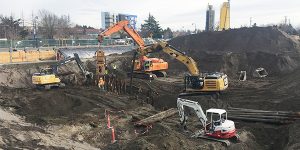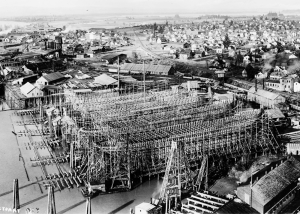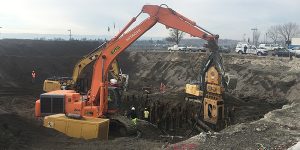Building from the underground up: Ground Stabilization
Developing Terminal 1 into a destination waterfront property is a complex process, and the first step is ensuring a solid ground to build on.

Crews spent nearly two months excavating and extracting 712 pilings from the site
Over the past few months, you may have seen a team at Terminal 1 preparing the site for this critical ground stabilization work. Contractor Keller North America has been performing the work and has over four decades of ground improvement experience.
The crew began operations in mid-October but hit some unexpected challenges related to the site’s prior use as a shipyard. In 1918, port commissioners entered into a contract with the G.M. Standifer Construction Corporation for the purpose of building ships. The Standifer shipyards built both wooden and steel ships at its Vancouver locations between 1918 and 1921 to aid in the World War I effort. Crews spent nearly two months excavating and extracting 712 timber pilings from the site’s prior operations.

The G. M. Standifer Construction Company built ships for the World War I effort between 1918 and 1921
This week, ground stabilization has officially resumed. This process will create the support needed for the AC Hotel by Marriott, a portion of the Renaissance Trail, the Vancouver Landing project and future dock work. It will also provide the structural support needed to minimize impacts of a seismic event.
So how does one make the soil stronger? Keller North America walked us through the process.
The stabilization design process started early on by examining soil sample logs and documentation to identify the work needed to meet the hotel’s structural and building code requirements. These requirements can often change depending on the building plan – elevators, kitchens, and parking garages may require a greater bearing capacity than other building elements. This leads to extremely close coordination between port staff, hotel designers, structural engineers and geotechnical engineers.
“There are a lot of checks and balances along the way,” said port Project Delivery Manager Mark Newell. “It’s a coordinated effort between multiple parties to make sure all requirements are being met.”

A closer look at the extraction process of the timber pilings
Onsite, there is a batch plant located outside of the work zone that mixes the cement with water to create a grout with predetermined properties. This grout is then pumped from the batch plant to the drill rig and is slowly introduced to the soil by a mixing auger. The auger mechanically blends the cement mixture into the existing soil in 5-foot diameter ‘columns’ anywhere from 30-60 feet below existing grade. Once the project is complete, nearly 600 of these columns will create the ground improvement system necessary to support the structure and minimize impacts during a seismic event.
Ground stabilization is expected to be completed before the end of March. At that time, crews will begin laying the hotel’s foundation – another exciting milestone for the Terminal 1 project.
As we see the redevelopment of Terminal 1 progress, the port is looking forward to highlighting the history of this special piece of land in our marketplace design.
For continued updates on this project, visit the Terminal 1 website or sign up here for the Terminal 1 newsletter: Waterfront Views.
